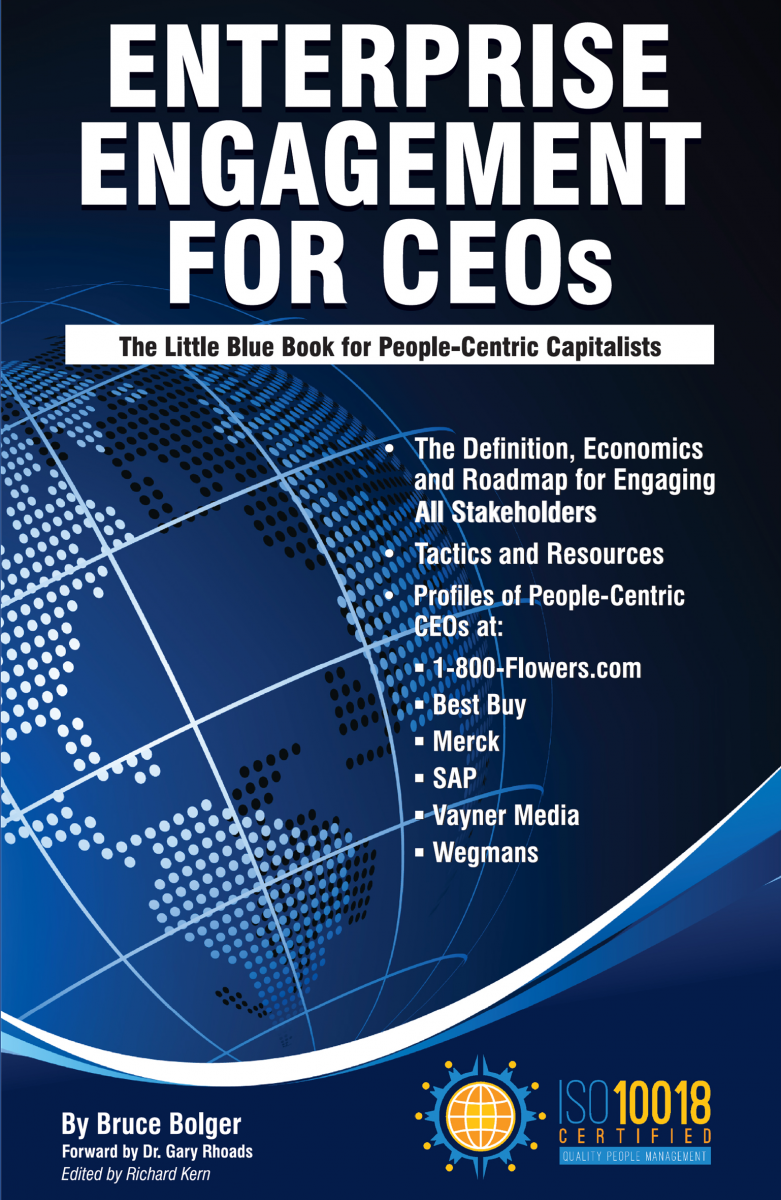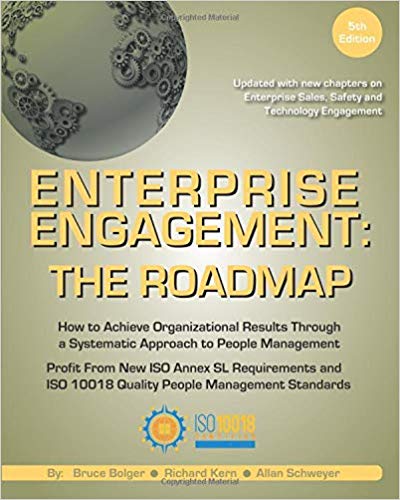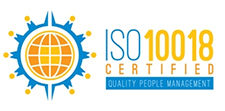When the Enterprise Engagement Alliance formally introduced the field of Enterprise Engagement in 2008, the goal was to provide organizations with a new path to sustainable success based on engaging all interested parties in the purpose of the enterprise. At that time, the EEA never imagined that world-leading organizations would so passionately embrace the benefits of addressing the needs of all stakeholders. Despite the promising talk, major obstacles stand in the way of actual implementation.
By Bruce Bolger, Dr. Ron McKinley, and Lee S. Webster

Leading organizations that include some of the world’s largest businesses have now embraced the importance of an enterprise approach to engaging and addressing the needs of all stakeholders. The challenge now is that most organizations today lack the critical resources and expertise necessary to put this new vision into action: that is the commitment of CEOs to make the necessary changes; the knowledge of how to put this talk into action, and agencies or consultants with the necessary expertise.
The concept of Enterprise Engagement, first developed in 2008, is defined in
Wikipedia as: a sub-discipline of
marketing and management that focuses on achieving long-term financial results by strategically fostering the proactive involvement and alignment of customers, distribution partners, salespeople, and all
human capital outside and inside of an organization.” Since then, these same principles have been embraced by multiple organizations and business leaders in the US and around the world.
Broad Agreement on the Need to Engage the Enterprise
ISO (International Organization for Standardization) in its Quality Management Principles, Annex SL requirements in over 60 business process standards, and the ISO 30414 Human Capital Internal and External Reporting standards, all underline the need to address the needs of all interested parties. Specifically, ISO 30414 calls for: “A formal engagement strategy to support the proactive involvement of employees to consistently address the needs of external and internal customers that aligns activities related to leadership training, engagement assessment, communications, learning, innovation and collaboration, rewards and recognition, analytics, and feedback.”
The Embankment Project for Inclusive Capitalism, founded by the Rothschild organization and Ernst & Young among others, was created on the premise that “Today, a company’s value is increasingly reflected not just in its short-term financial performance, but also by intangible assets such as intellectual property, talent, brand and innovation, as well as impacts on society and the environment, that are not fully captured by traditional financial statements.”
The
Business Roundtable’s new statement of purpose for the corporation commits 181 signers to lead their companies “for the benefit of all stakeholders—customers, employees, supplies, communities, and shareholders.”
The Davos Manifesto, published by the prestigious World Economic Council, which goes so far as to call the concept “Stakeholder Capitalism” writes: “The purpose of a company is to engage all its stakeholders in shared and sustained value creation. In creating value, a company serves not only its shareholders, but all its stakeholders—employees, customers, suppliers, local communities, and society at large.”
Top business leaders and influencers, including Larry Fink, Blackrock CEO, Businessinsider.com owner Henry Blodgett, Salesforce.com founder Marc Benioff, and many more have embraced the need for a strategic and systematic approach to addressing the needs of all stakeholders.
The American public. A survey of over 4,000 Americans by JUST Capital found that: “Regardless of politics or demographics, employees would be willing to work for a ‘just’ company for less pay and most respondents say they have made a purchasing or job decision based on their perception of the organization.”
The Barriers to Action: Lack of Knowledge, Expertise, and Silos
While there now exists broad agreement on the fragment for sustainable success, there are major obstacles to translating these principles into action. The keys to successful implementation of a stakeholder engagement strategy are:
• CEO leadership
• A strategic enterprise engagement plan
• Relevant human capital internal and external reporting processes
• A clear brand, values, and mission statement that addresses the needs of all stakeholders
• An understanding of the inter-related needs and common interests of all stakeholders
• Total integration and alignment of traditionally siloed external marketing, sales, and corporate responsibility processes with such internal tactics as recruitment, assessment, coaching, communications, learning, job design, loyalty, innovation, diversity, benefits, rewards and recognition, etc.
• Continuous improvement and measurement processes.
The challenge is that most organizations lack many of these key elements because of the following factors:
Lack of knowledge. The concept of an enterprise approach to engaging and addressing the needs of all stakeholders is alien to traditional leadership, almost none of whom could possibly have received any practical training on the subject because the concept is not taught in schools and exists almost nowhere else but from the Enterprise Engagement Alliance at
TheEEA.org, which at this time is little known to the general business public.
Lack of leadership. At most organizations, the engagement of customers, distribution partners, employees, and communities is divided among different management teams, with efforts often working either independently or at cross purposes. This results in major inefficiencies and poor stakeholder experiences.
Branding deficiencies. Most brands are defined by the story they tell customers. The concept of stakeholder or enterprise engagement requires a brand that addresses the needs and interests of all interested parties, a concept rarely taught in marketing.
Management siloes. Many organizations continue to be run in a departmental structure; i.e., marketing, finance, operations, sales, human resources, administration, etc., which often focus more attention on their own internal needs and interests than they do of the enterprise and its external and internal customers. Enterprise engagement demands a level of alignment rare at most organizations.
Lack of measurement. Because human capital investments are usually considered an expense, there is remarkably little return-on-investment measurement of such practices as: recruitment, coaching, communications, learning, rewards and recognition, loyalty programs, etc. At best, such tactics are measured by surveys indicating satisfaction or at best effectiveness, but with little correlation to measurable impact on organizational outcomes.
Almost no expertise with an enterprise approach. Most consultants or marketing agencies focus either on external or internal audiences, or focus on specific tactics such as marketing, recruitment, training, rewards and recognition, etc. so that there is little tactical alignment.
Where to Turn for a Roadmap
Now that awareness is growing for the concept of an enterprise approach to engagement and the more ambitious “Stakeholder Capitalism” movement, there eventually will be a broader choice of resources to help those organizations seeking an action plan. For now, here are the available resources we know of for organizations seeking a strategic and systematic approach to engaging and addressing the needs of all stakeholders:
The ISO 10018 guidelines on people involvement and competence provides a framework for addressing the needs of all stakeholders in the management of an organization.
Enterprise Engagement for CEOs provides a short introduction for CEOs and management seeking to understand how to profit from an enterprise approach to engaging all stakeholders and the concept of stakeholder capitalism.
Enterprise Engagement: The Roadmap provides the most comprehensive guide to all the strategies, tactics, and applications for an enterprise engagement approach to engagement.
The ISO 10018 guidelines on people involvement and competence provides a framework for addressing the needs of all stakeholders in the management of an organization. The standard can be purchased shortly again from ISO as it is currently being updated. In the meantime, here’s a
report on the current standard.
Wikipedia. The first entry for Enterprise Engagement was made in 2009 and provides a simple definition and framework, including the economic benefits.
Free Short course. 10-minute short course:
click here for a 10-minute introduction to Enterprise Engagement and ISO standards on Coggno.com learning platform.
EEXAdvisors.com. The first and only continually updated, curated online director of solution providers who can assist with a strategic and systematic approach to engaging all stakeholders. Includes over 30 categories of solution providers from 360-degree branding, recruitment, coaching and communications, to learning, job design, innovation, diversity, loyalty, rewards and recognition, analytics, and more.
Master the Principles of Enterprise Engagement to Achieve Organizational Goals and Enhance Your Career
-
Profit from a new strategic and systematic approach to engagement to enhance your organization’s brand equity; increase sales, productivity, quality, innovation, and safety, and reduce risks.
-
Get trained to become a Chief Engagement Officer for your organization.
-
Achieve ISO 10018 Quality People Management Certification to demonstrate your organization’s strategic commitment to people to your customers, employees, distribution partners, vendors, communities, investors, and regulators.
-
Learn how to create Sustainability or Integrated Reports for Your Organization or Clients.
-
Get up-to-speed on ISO human resources standards and guidelines to enhance HR performance.
Live Education: Enterprise Engagement in Action. Take advantage of scheduled monthly live webinar preparation courses for the Certified Engagement Practitioner designation consisting of three one-hour classes and of quarterly Advanced Engagement Practitioner courses consisting of three one-hour webinar classes. The AEP course is for individuals or teams seeking preparation ISO 10018 professional certification status. ICEE periodically runs regional one-day workshops on ISO 10018 Quality People Management principles and certification.
Resources: The Brand Media Coalition, the only guide to the story-telling power of brands and where to source them for business, event, promotional gifting, and rewards and recognition. 2019 Enterprise Engagement Solution Provider Directory. The only directory of engagement solution providers covering all types of agencies and tactics as well as insights on how to select them.
Communities: The Enterprise Engagement Alliance and Advocate and the Brand Media Coalition free resource centers offering access to the latest research, news, and case studies; discounts, promotions, referrals, and commissions, when appropriate to third-party solution providers from participating coalition solution provider members.

In Print:
Enterprise Engagement: The Roadmap 5th Edition
The first and most comprehensive book on Enterprise Engagement and the new ISO 9001 and ISO 10018 quality people management standards. Includes 36 chapters detailing how to better integrate and align engagement efforts across the enterprise. (312 pages, $36.)
 Online:
Online:
10-minute short course: click here for a 10-minute introduction to Enterprise Engagement and ISO standards from the Coggno.com learning platform.
Services:
• The International Center for Enterprise Engagement at TheICEE.org, offering: ISO 10018 certification for employers, solution providers, and Enterprise Engagement technology platforms; Human Resources and Human Capital audits for organizations seeking to benchmark their practices and related Advisory services for the hospitality field.
• The Engagement Agency at EngagementAgency.net, offering: complete support services for employers, solution providers, and technology firms seeking to profit from formal engagement practices for themselves or their clients, including Brand and Capability audits for solution providers to make sure their products and services are up to date.
• C-Suite Advisory Service—Education of boards, investors, and C-suite executives on the economics, framework, and implementation processes of Enterprise Engagement.
• Speakers Bureau—Select the right speaker on any aspect of engagement for your next event.
• Mergers and Acquisitions. The Engagement Agency’s Mergers and Acquisition group is aware of multiple companies seeking to purchase firms in the engagement field. Contact Michael Mazer in confidence if your company is potentially for sale at 303-320-3777.
Enterprise Engagement Benchmark Tools: The Enterprise Engagement Alliance offers three tools to help organizations profit from Engagement. Click here to access the tools.
• ROI of Engagement Calculator. Use this tool to determine the potential return-on-investment of an engagement strategy.
• EE Benchmark Indicator. Confidentially benchmark your organization’s Enterprise Engagement practices against organizations and best practices.
• Compare Your Company’s Level of Engagement. Quickly compare your organization’s level of engagement to those of others based on the same criteria as the EEA’s Engaged Company Stock Index.
• Gauge Your Personal Level of Engagement. This survey, donated by Horsepower, enables individuals to gauge their own personal levels of engagement.
For more information, contact Bruce Bolger at Bolger@TheEEA.org, 914-591-7600, ext. 230.
 Leading organizations that include some of the world’s largest businesses have now embraced the importance of an enterprise approach to engaging and addressing the needs of all stakeholders. The challenge now is that most organizations today lack the critical resources and expertise necessary to put this new vision into action: that is the commitment of CEOs to make the necessary changes; the knowledge of how to put this talk into action, and agencies or consultants with the necessary expertise.
Leading organizations that include some of the world’s largest businesses have now embraced the importance of an enterprise approach to engaging and addressing the needs of all stakeholders. The challenge now is that most organizations today lack the critical resources and expertise necessary to put this new vision into action: that is the commitment of CEOs to make the necessary changes; the knowledge of how to put this talk into action, and agencies or consultants with the necessary expertise.
 Online:
Online: 














